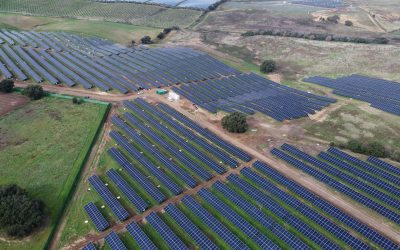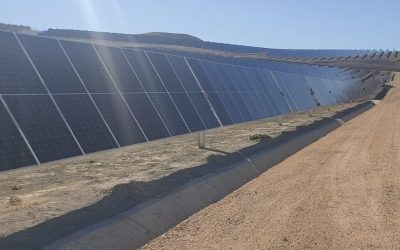Peter Karam, COO of BNZ, discusses the potential of solar panels to deal with the current drought situation in southern Europe
A lack of precipitation and unusual high temperatures during the first half of spring 2023 have raised concerns in southern Europe. In Spain, data indicate that last year was the sixth driest in its history and the warmest since 1961, when records began. In addition, rainfall was 16% below average and the average daily temperature exceeded 15°C for the first time.
The worst drought in seven decades hit in the summer of 2022, when the Po, Italy’s largest river, which irrigates about a third of Italy’s agricultural production, recorded a severe water deficit. Portugal has also been one of the countries affected. Last May, its government declared severe and extreme drought in about 40 % of the national territory, in the southern half of the country, due to high temperatures and low rainfall in March and April.
These extreme weather events highlight the need to address this problem and take measures to mitigate its effects on agriculture, water supply and the environment in general. In this respect, solar photovoltaic power plants can be of great help. Solar panels are presented as an alternative, not only to curb climate change and prevent these events, but also to improve groundwater management and help manage drought.
1. Conservation of water resources and reduction of evaporation
Water conservation is a crucial issue nowadays, especially due to the growing demand and scarcity of this vital resource. In this sense, solar plants are a promising solution, as they harness the sun’s energy and do not require water for their operation, unlike conventional electricity sources, such as thermal or hydroelectric power plants, which need large volumes of water to generate electricity.
The installation of solar panels not only has benefits in terms of clean energy generation, but can also contribute to the reduction of soil evaporation. When solar panels are installed in a certain area, they cover part of the ground and provide shade, which helps to reduce the direct exposure of the ground to solar radiation and wind. This coverage has a positive effect on reducing the evaporation of water from the soil. By reducing evaporation, soil moisture is retained longer, which directly benefits the plants and crops that depend on that water supply. In addition, by reducing evaporation, fires due to drought are prevented, especially in arid or water-scarce regions.
2. Water management and aquifer recharge
The installation of solar plants can play an important role in reducing runoff and recharging aquifers. Below are some key aspects of how solar plants can achieve this:
- Green infrastructure: Solar plants, in addition to PV panels, often include areas of cleared land. These areas can be designed and managed to act as green infrastructure, which involves incorporating natural features that promote water infiltration into the soil. This includes planting trees, shrubs and other plants that have root systems that help break up soil compaction and increase its ability to retain water.
- Stormwater management: Solar plants can implement stormwater management systems that capture and store rainwater for use during droughts, as well as redirect rainwater to areas where it can infiltrate into the ground. This is achieved through the construction of infiltration trenches, retention basins or sustainable drainage systems that allow for the gradual infiltration of water.
- Permeable pavements: Instead of using conventional pavements, the areas around solar plants can be lined with permeable materials. These pavements allow rainwater to percolate through and reach the underlying soil instead of generating surface runoff.
- Soil conservation: Soil erosion is a major cause of runoff. By implementing soil conservation practices, such as planting cover crops or implementing minimum tillage techniques, erosion can be reduced and greater infiltration of water into the soil can be promoted.
- Appropriate hydrological design: When planning the construction of solar plants, it is important to consider the hydrology of the site. This involves understanding the terrain characteristics, topography, water flow patterns and nearby aquifer recharge areas. By considering these factors, design decisions can be made that maximise water infiltration into the ground and minimise runoff.
- Improved water quality: Traditional power plants often discharge hot water into bodies of water, causing thermal pollution. Solar panels do not generate such thermal pollution, thus maintaining the water quality of rivers, lakes and reservoirs. Improved water quality supports healthy ecosystems and can help maintain water supplies during periods of drought.
In this sense, solar panels also provide a renewable energy source that can power water treatment plants and desalination facilities. This reduces dependence on conventional energy sources and helps ensure the availability of clean water during non-rainy periods, especially in coastal areas where desalination plays a crucial role in water supply.
3. Land management and dual use
The coexistence of solar energy and agriculture, agrivoltaics, can also provide certain benefits that help mitigate the effects of drought. Through the placement of solar panels on crops, photovoltaics can provide shade, reduce evaporation of water from the soil or protect crops against adverse weather conditions. In this sense, reduced evaporation and temperature moderation under shade can create a more favourable microclimate for crops, resulting in improved water use efficiency and reduced irrigation needs.
In addition, agricultural solar farms can be designed to incorporate vegetation management practices that support soil health and water retention. Planting native grasses or other vegetation under or around solar panels can help improve soil moisture, increase organic matter content and improve infiltration rates, indirectly benefiting aquifer recharge.
Another strategy that can be adopted is the use of efficient irrigation systems and water control technologies. This includes the implementation of drip irrigation systems, which provide water directly to the plant roots, thus minimising evaporation losses and ensuring a more accurate and efficient use of the water resource. In addition, sensors and monitoring systems can be used to measure soil moisture and plant water demand, allowing irrigation to be optimally adjusted and avoiding wastage.
4. Drought impact mitigation and climate resilience
Addressing climate change is key to sustainable water management. Solar plants produce renewable energy and mitigate climate change, the effects of which can lead to drought. In addition, they are also compatible with rainwater, as they can optimise the energy efficiency of solar plants, as rain cools and cleans the panels. In this way, a reduction of up to 12% in energy generation can be avoided by removing airborne particles and dirt.
Finally, solar energy can also reduce dependence on water for maintenance by allowing alternative cleaning methods to be adopted compared to other conventional energy production methods.
Photovoltaics, a long-term asset for a sustainable response to the water crisis
However, the installation of solar panels is proving to be an alternative for dealing with the current drought situation in southern Europe. The peninsular reservoirs have experienced a slight decrease in their volume of stored water and are currently at 47.4% of their capacity. These figures are lower than those recorded on the same dates in 2022 and are 19 points below the average for the last decade, which is 66.7%.
In this sense, dams for electricity production are at 64.3% of their capacity, also below the average values of the last decade (77%). For this reason, it is not only essential to implement systems that contribute to reducing soil evaporation or rainwater harvesting, but also to promote other renewable energy sources such as photovoltaic energy, whose potential does not depend exclusively on water resources.


